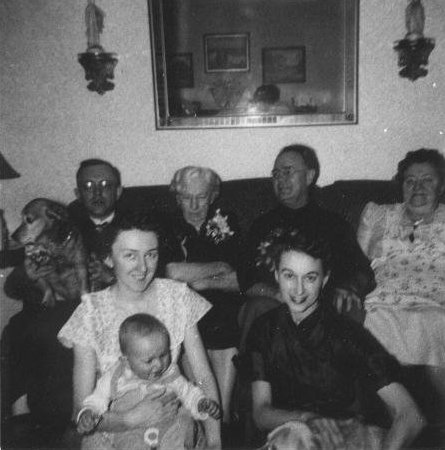
Mothers Day. The photo above, from sometime early in 1953, is an interesting one: It presents four generations of Duntemanns, including four mothers. Back row, L-R: Frank W. Duntemann 1922-1978. Martha Winkelmann Duntemann 1871-1967. Harry G. Duntemann 1892-1956. Sade Prendergast Duntemann 1892-1965. Front row: Kathleen M. Duntemann 1920-1999. Victoria Pryes Duntemann 1924-2000. Basically, my father, my great-grandmother, my grandfather, my grandmother, my godmother, and my mother. (And me. My godmother Aunt Kathleen is holding me to keep me from harrassing my mother’s poor cocker spaniel.) I miss them all, and thank them all for various things, but mostly for just being who they were.
Martha Duntemann was a remarkable woman. She survived all four of my grandparents (including her oldest son Harry) and lived longer than anyone in my direct line of descent, as far back as I can see. (Only one person anywhere in my family tree lived longer, and by less than two years.) She lived in a second-floor flat, and went up and down the (outside) stairs without assistance until three weeks before she died at age 96. I didn’t get a great deal of time with her (I was one of 19 great-grandchildren) and didn’t appreciate at age ten or eleven that when she hugged me hello I was touching a living link to the 1870s.
I appreciate it now. And I can show Martha in a better light in the photo below, from 1900:

The man is her husband Frank W. Duntemann (after whom my father was named) 1867-1936, and the boys are Elvin F. Duntemann 1895-1979 and my grandfather Harry. Frank was the postmaster of Orchard Place, Illinois (from which the abbreviation ORD for O’Hare Field was derived) and owned the little town’s general store.
I guess people just didn’t say, “Smile for the camera!” in 1900. The good news is that when I remember Martha in her 90s, I remember her smiling. If I live that long (and I certainly hope to give it a good shot) I intend to do the same.











The reason they didn’t smile for the camera during the 19th century is that the emulsion was so slow that exposures could take as long as 5 minutes; even in bright sun. If you have ever tried to smile that long, you would know it wasn’t pretty. For this reason, the pictures of the dead were usually quite sharp but pictures of the living were not so good. A contributing factor was that the lens of the day would not be considered “fast” by our standards because of their small diameters.
Attempting to get around these limitations led to some interesting attempts to hold the subject motionless and increase the light on the scene. For a humorous take on the situation, watch the scene in the photographer’s studio in the movie “The Apple Dumpling Gang Rides Again.”